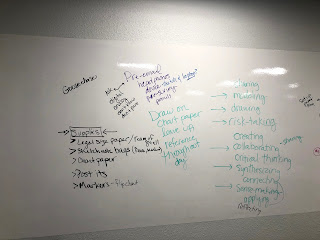May I make a book recommendation? My favorite edu-read of the past year is The New Pillars of Modern Teaching by Gayle Allen, and this book has truly changed the way I think about teaching and learning.
In the book, Dr. Allen shares the reasons why educators must shift from the old pillars (instruction, curriculum, assessment) to the new pillars of design, curation, and feedback. The three primary chapters share how we transition from the old to the new pillar, give an example of that pillar in the "real world," provide what it looks like for students and what it looks like for educators. The book is tiny (44 pages!) but packs such a powerful punch that I keep it with me at all times and constantly refer to it. My colleagues and I embed the new pillars in almost every professional learning session we provide, and we even created sessions on each of the three individual pillars!
At first glance, the book does not look like a technology book, but oh yes, it's all about WHY we must embrace technology for our teaching and learning. The book is all about empowering learners, whether you're a student or teacher, and it helps us understand the impact of living in a time of information abundance. (This idea supports a favorite quote from Alice Keeler, "Teach like Google and YouTube exist!") Teachers no longer need to be "the funnel and the filter" of the learning, but Dr. Allen says the change doesn't diminish teachers' roles, it enhances it! In each of the chapters, she reminds educators that we must experience this type of learning ourselves (with the technology) if we are to help our students own their own learning. The book includes tech tool recommendations, but of course, it's not all about the technology.
The other thing I love about the book is that I get the feeling that Dr. Allen truly understands educators' lives: our time constraints, our school/district mandates, and trying to keep up with it all. She knows we're trying to move mountains, so the book is filled with reminders such as, "It's not important which technology we choose--just that it helps us achieve our goals." And "the key is to start small..." She provides choices, helps us understand our preferences, and presents compelling reasons for us to transition to the new pillars. And by the way, chapter 5 is Iteration and Failing Fast to Learn, so she includes ideas related to #growthmindset, too! "The key is to get past perfection paralysis."
Commercial: by the way, my colleagues and I are hosting our second free, online book study over The New Pillars, and you're welcome to join us on this journey! Beginning October 17, 2017, we'll explore one chapter per week, and share ideas with a podcast, learning tasks, and Twitter discussions.
Second commercial: Dr. Allen's podcast, Curious Minds, is one of my favorites. Her interviews are outstanding, and her depth of knowledge and questions to the authors are so interesting that I want to read every one of the featured books! She is also extremely active on Twitter and shares fascinating posts, research, and ideas.
Have I piqued your interest? Have you already read The New Pillars of Modern Teaching? Do you have another book that has completely transformed your ideas about teaching and learning in the digital age?
In the book, Dr. Allen shares the reasons why educators must shift from the old pillars (instruction, curriculum, assessment) to the new pillars of design, curation, and feedback. The three primary chapters share how we transition from the old to the new pillar, give an example of that pillar in the "real world," provide what it looks like for students and what it looks like for educators. The book is tiny (44 pages!) but packs such a powerful punch that I keep it with me at all times and constantly refer to it. My colleagues and I embed the new pillars in almost every professional learning session we provide, and we even created sessions on each of the three individual pillars!
| #booksnap from the Introduction |
Commercial: by the way, my colleagues and I are hosting our second free, online book study over The New Pillars, and you're welcome to join us on this journey! Beginning October 17, 2017, we'll explore one chapter per week, and share ideas with a podcast, learning tasks, and Twitter discussions.
Second commercial: Dr. Allen's podcast, Curious Minds, is one of my favorites. Her interviews are outstanding, and her depth of knowledge and questions to the authors are so interesting that I want to read every one of the featured books! She is also extremely active on Twitter and shares fascinating posts, research, and ideas.
Have I piqued your interest? Have you already read The New Pillars of Modern Teaching? Do you have another book that has completely transformed your ideas about teaching and learning in the digital age?





